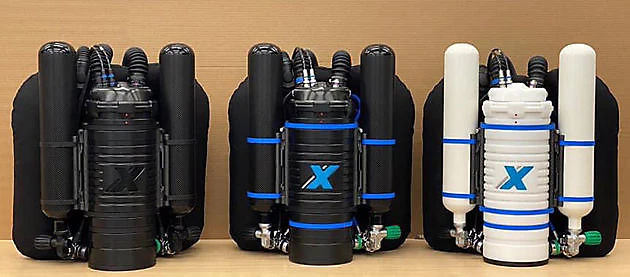The XCCR is a closed-cycle rebreather (CCR) manufactured by iQsub. It is designed for technical divers who want a more efficient and versatile diving device.
Unlike open-cycle scuba equipment, which releases exhaled gases into the water, CCR recycles exhaled gases by removing carbon dioxide and adding oxygen to maintain an optimal breathing mixture.
We will pay special attention to both the construction of the device and the test reviews to give you a comprehensive overview of this rebreather, the questions asked by scuba divers to the coach of the club “Daivings.lv”. Log in and try eCCR CE Rebreather with an instructor (Introduction to rebreather diving).
Construction parameters
- Design: The XCCR is a back-mounted CCR with a radial scrubber that provides efficient CO2 removal. It is a modular design that allows for customization of various components to suit the diver's needs.
- Materials: The device is made of durable materials such as stainless steel and titanium to ensure longevity and corrosion resistance.
- Electronics: The XCCR uses advanced electronics to control and monitor breathing gases. It has multiple sensors that measure oxygen levels, CO2 levels, and pressure.
- Safety: The device has several safety features, including automatic oxygen addition if oxygen levels become too low and failure alerts.

Features
- Closed-loop operation: Uses gas efficiently, extending dive time and reducing gas consumption.
- Electronic oxygen control: Maintains optimal oxygen levels in the breathing mixture.
- CO2 monitoring: Ensures that the CO2 level in the breathing mixture is safe.
- Multi-gas support: Allows divers to use different breathing mixtures, such as nitrox and trimix.
- Data recording: Records dive data such as depth, time and breathing gas composition.
Testing reviews
- Users often note the XCCR as a very reliable and durable device. Its electronics are precise and the safety features are effective.
- Many divers appreciate the XCCR's modular design, which allows you to customize the device to suit individual needs.
- Initially, beginners may find it difficult to learn how to use the XCCR, so it is recommended to take appropriate diving courses before using the device.
Beginner's considerations
- CCR diving is more complex than open-circuit diving and requires thorough training.
- The XCCR is a high-end device and can be expensive to purchase.
- Regular maintenance of the device is required to ensure its safe operation.
Summary
The XCCR is a high-performance CCR suitable for technical divers who want efficient and versatile diving equipment. However, beginners should note that CCR diving requires thorough training and comes with additional costs.
Let's expand on the information about the XCCR rebreather to gain a more detailed understanding.
XCCR Rebreather parameters:
- Dimensions (HxWxD): 70 x 40 x 25 cm. These dimensions indicate the volume of the rebreather and how big it is.
- Weight:
- 34.0 kg (without soda lime and gas): This is a basic weight, useful when traveling.
- 21.4 kg (without balloons and soda lime): Even lighter, suitable for air transport.
- 38.5 kg (ready to dive): Total weight with cylinders and soda lime, ready to dive.
- Temperature limits:
- Diving: Water temperature must be above 4°C and below 34°C, according to EN14143:2013 standards.
- Transport: +4 °C to +40 °C.
- Storage: +5 °C to +25 °C.
- Atmospheric pressure range: 800-1050 mbar.
- Maximum application depth:
- 40 m with air as diluent.
- 100 m with Trimix 12/65 (or higher) as diluent.
- Warning: Diving deeper than 100 m significantly increases the risks and is not recommended.
CO2 scrubber and soda lime parameters:
- CO2 scrubber type: Radial, with self-filling function.
- Soda lime:
- 3.2 kg (Sofnolime 797 or equivalent).
- Operating time: Up to 6 hours under moderate load.
- Type of soda lime: Sofnolime 797 (1-2.5 mm), non-indicating or white to purple, manufactured by Molecular Products Limited, UK.
Cylinder and gas parameters:
- Rear anti-roll bars: 2×4.0 liters.
- Front anti-shoulders: 2×3.8 liters.
- Oxygen cylinder: Eurosteel cylinder 3 liters, 232 bar or 300 bar, with monovalve M26x2.
- Diluent cylinder: Eurosteel cylinder 3 liters, 232 bar or 300 bar, with monovalve DIN 5/8″.
- Required gas purity:
- Air: EN 12021.
- Oxygen: ≥99.5% (medical oxygen).
- Helium: ≥99.99% (Hel 4.0).
Regulator and control parameters:
- Oxygen Stage 1 Regulator: Connection M26x2, average pressure 9.5 +/- 0.5 bar.
- Diluent stage 1 regulator: Connection DIN 5/8″, average pressure 9.5 +/- 0.5 bar.
- Oxygen control: Readings from three oxygen sensors with voting logic.
- Oxygen sensors: 3 galvanic rebreather oxygen sensors, type NaNS01 SMB (coaxial), M16x1, output 9-13 mV.
- Oxygen setting range: 2 variable settings, adjustable from 0.5 to 1.5 bar O2.
- Oxygen alarms:
- Low oxygen level: 0.4 bar or less.
- High oxygen level: 1.6 bar or more.
- CO2 sensor: Solid state optical sensor, range 0-5% CO2.
Electrical and safety parameters:
- In the battery head part: 2 independent 3.7V lithium-ion batteries, size 18650, user-replaceable.
- Batteries in the handheld device: 1 AA size 1.5V alkaline or 3.6V Saft or 3.7V lithium-ion rechargeable battery.
- Safety devices:
- Pressure relief valve on the oxygen manifold (15-18 bar).
- Safety pressure valve on the head part (3-5 bar).
- Floating control device: Wing type BCD X-20, buoyancy 200N.
- Back plate: 3 mm stainless steel with fixed or adjustable straps.
- Tripod: Made of stainless steel or titanium, additional height 80 mm, 120 mm, 140 mm.
This detailed information provides a comprehensive overview of the technical specifications of the XCCR rebreather, useful for both beginners and experienced divers.

